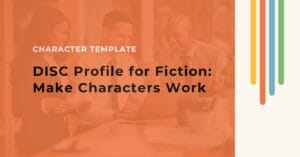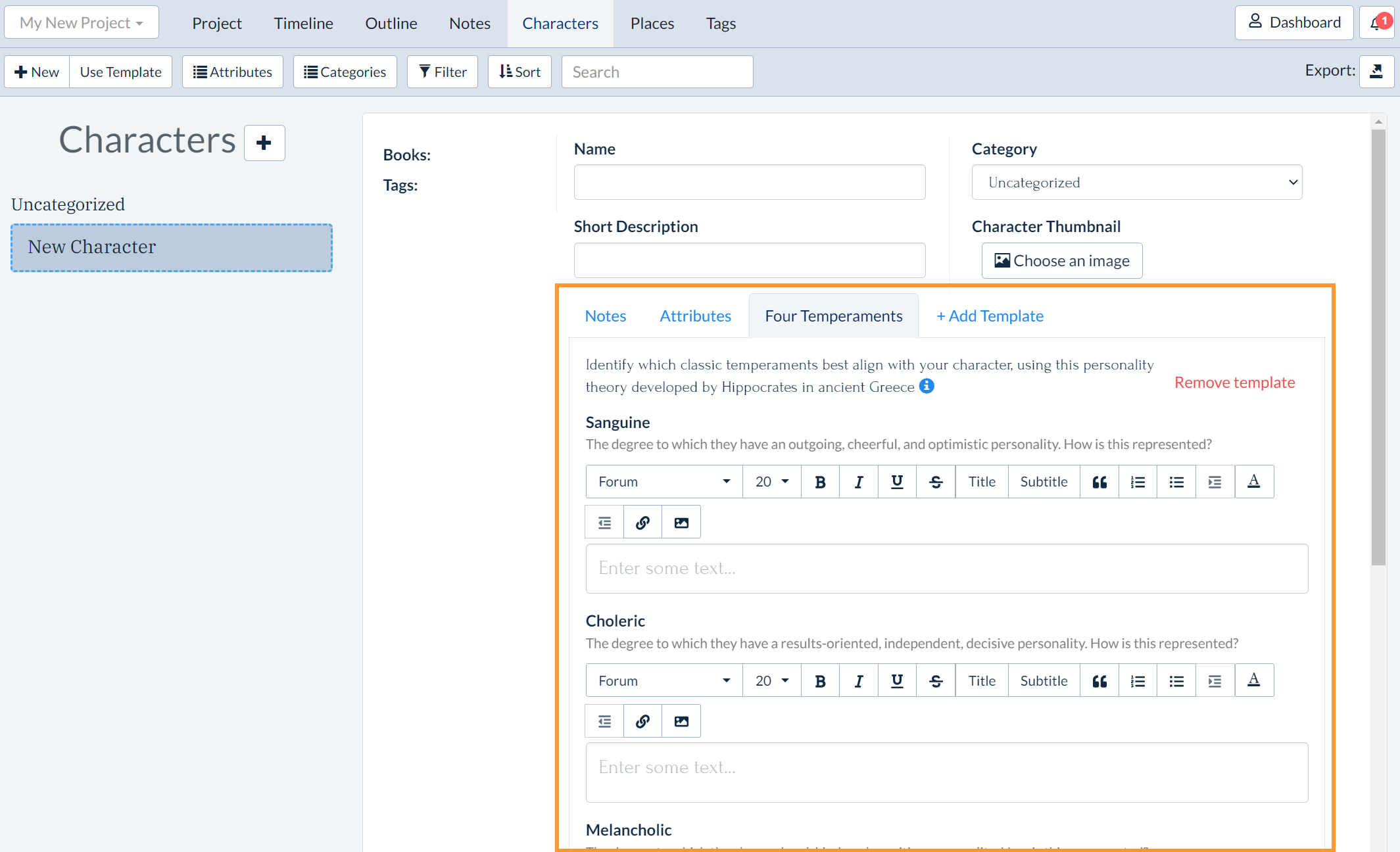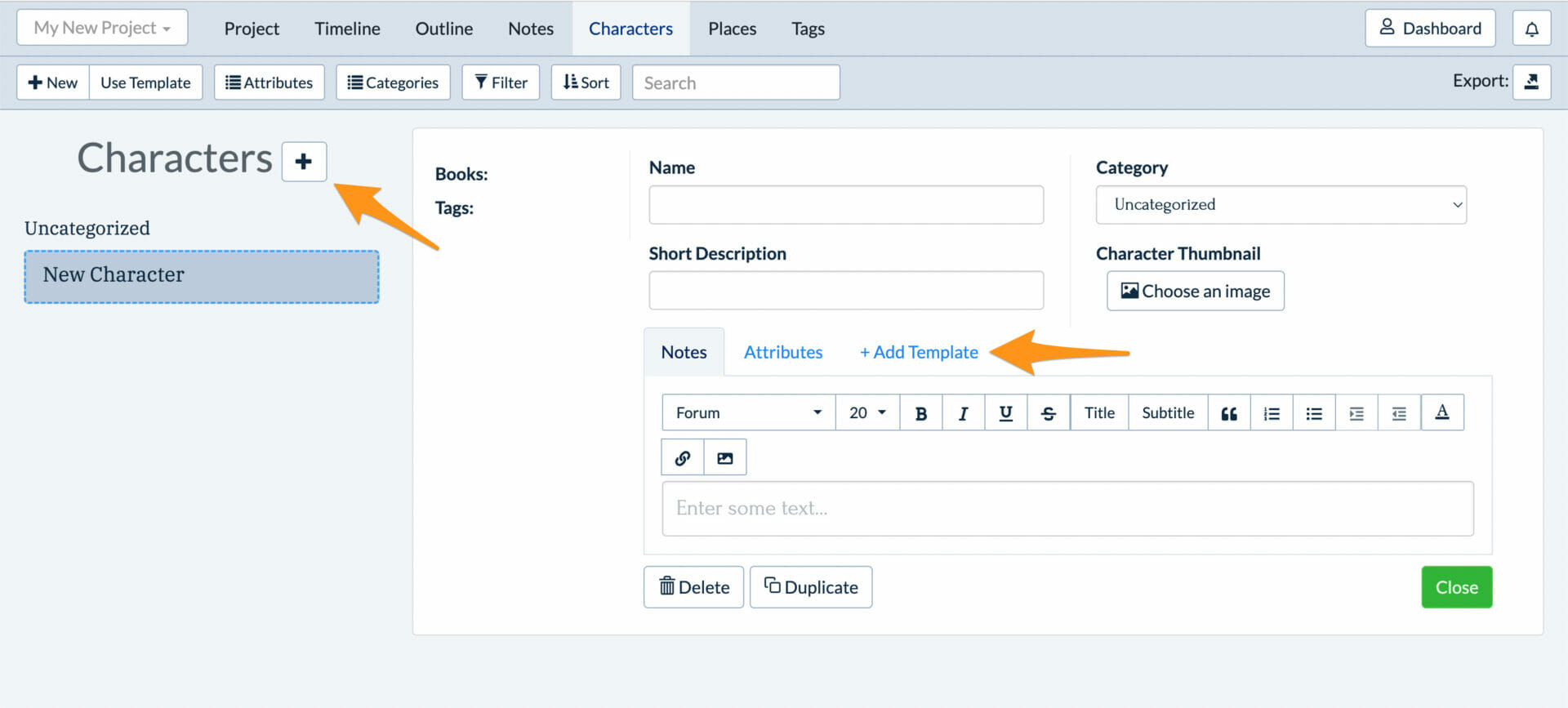
Organize your creativity with the #1 book outlining and story bible software for professional and aspiring writers.
Product
Helpful Links
© Fictional Devices, 2024. All Rights Reserved.
Great characters come to life through their traits and temperaments. There are many ways to develop characterization, and the four temperaments (also known as the ‘four humors’) is one helpful approach.
In this article, you’ll learn what the four temperaments are, why you should use them to outline your cast, and how you can use the Four Temperaments Character Template in Plottr to keep your characters consistent.
The Four Temperaments theory was developed by the ancient Greek physician Hippocrates, who was born in 460 BC. The theory is rooted in the system in ancient Greek medicine called humorism. This was the idea that human personalities and behaviors are affected by four bodily fluids, or humors.
These four humors were blood, yellow bile, black bile, and phlegm. You may be thinking, “Gross! These classical thinkers had some wild ideas.” Yet the theory provides useful tools for building characterization.
Although temperaments theory was developed more than 2,000 years ago, and the biological component has long been debunked, it remains a useful comparative approach for thinking about people’s dispositions and inclinations and how these impact their behavior.
The Four Temperaments Character Template in Plottr asks you how much of each temperament your character contains, and how it comes through in his or her actions. Keep in mind that characters can be a combination of types, opening up a vast world of combinations.
The Four Temperaments (in our more modern way of seeing them) are:
Each of the above is a useful quality to identify in your characters. Temperaments add depth and relatability, as readers will connect with tendencies that they recognize. Using the temperaments will help ensure characters aren’t too alike or easily confused, too.
Having characters with different temperaments also helps to create the tension and conflict necessary to propel a story’s plot and character growth forward.
As you’re planning out your story, use your knowledge of the Four Temperaments to help you:
Assign these temperaments to your cast in the planning stages, and you’ll be able to build riveting conflict between characters, because you’ll know how opposing temperaments will be likely to clash.
The Four Temperaments Character Template in Plottr gives a focused structure to your character profile. You’ll create the profile with standard information (your character’s name, role, and category) to start, and then add the Four Temperaments template to add further details.
The template includes a section for each possible temperament, with a reference to their definitions. At the top, next to the description, a blue information icon features a link to this resource on the four temperaments. Use this reference to learn more.
Plottr’s template outlines the four temperaments like this:

The first temperament is Sanguine. How outgoing, cheerful and exuberant your character is.
Next is Choleric, which covers how results-oriented, independent, or decisive your character is.
Third is Melancholic, characterized by the degree to which they have a loyal, kind, and sensitive personality.
And finally we have the Phlegmatic temperament, or the degree to which they have a service-oriented, introverted, or passive/agreeable personality.
In each of these four categories, you’ll see a text box where you can specify how your characters match these temperaments and how you’ll represent that in your story.
Let’s examine these different temperaments using the characters from the classic children’s story Winnie the Pooh by A.A. Milne.
Outgoing, cheerful, and optimistic? You know which Hundred Acre Wood resident this describes… Tigger, with his insistent bounciness and chatter, fits the bill perfectly.
Sanguine types are often talkative and distractible and have a million disorganized projects going on at once. They like to be involved in lots of things, but that results in them being pulled in several different directions.
Although sanguine types may shun organization, it can actually help them.
Other famous Sanguine characters: Anna from Frozen, Naveen from The Princess and the Frog, Ferris in Ferris Bueller’s Day Off, Rapunzel from Tangled, and Lumiere from Beauty and the Beast.
This temperament may at times be irritable and quick to anger due to a decisive (some may say impatient), results-oriented nature.
CEOs, leaders, and take-charge types like Rabbit in Winnie the Pooh fall into this category. Some may see them as bossy. It’s a fine line.
Cholerics can be competitive to a fault, and their need to control everything can create both positive and negative outcomes — for themselves and for others.
Other famous choleric characters: The Beast from Beauty and the Beast, Mushu in Mulan, Hans in Frozen, and Hans Gruber from Die Hard. (What’s with the name Hans and choleric temperaments?)
This is the easiest temperament to identify in Winnie the Pooh because Eeyore is synonymous with melancholy. Poor Eeyore, always so blue.
Melancholic characters like Eeyore can seem pessimistic or depressed when they say things like, “It’s not much of a tail, but I’m sort of attached to it.”
Because they have a strong negative bias, melancholics crave security to alleviate their anxiousness. They’re resistant to change and are not typically risk-takers. On the positive side, however, they are often loyal and kind.
Other famous melancholic characters: the Tin Man from The Wizard of Oz, Cogsworth from Beauty and the Beast, Carl from Up, Sadness from Inside Out, and Charlie Brown.
Winnie the Pooh is the perfect unbothered, phlegmatic character. He has a service-oriented, introverted, and agreeable personality.
If you need a ride-or-die friend, a phlegmatic is your gal or guy. They’re also deliberate, thoughtful, and enjoy an easygoing life filled with the enjoyment of simple pleasures, like … pots of honey!
Other famous phlegmatic characters: Yoda from Star Wars, Grogu from The Mandalorian, Bosley from Charlie’s Angels, Sue from The Fantastic Four, and Mrs. Potts from Beauty and the Beast.
The Four Temperaments model is also useful if you want to develop particular groups of people in your novel. Especially if you want to give each group its own character. For instance, the four Hogwarts houses fit loosely into this framework.
If you’re ready to start filling in your own Four Temperaments Character Template in Plottr, you will need to either purchase Plottr or sign up for a free trial.
When you have Plottr set up on your computer and are ready to start utilizing the template, follow these easy steps.



Now you’re even closer to creating characters readers will remember long after they finish the last page of your story. If you want to add further character qualities, this template goes well with:
Using the Four Temperaments Character Template in Plottr will help you create characters just as memorable as the inhabitants of the Hundred Acre Wood.
As Piglet says, “The things that make me different are the things that make me, me!”
Get started with Plottr today, and let us know what you think in the comments!


© Fictional Devices, 2024. All Rights Reserved.
Comments